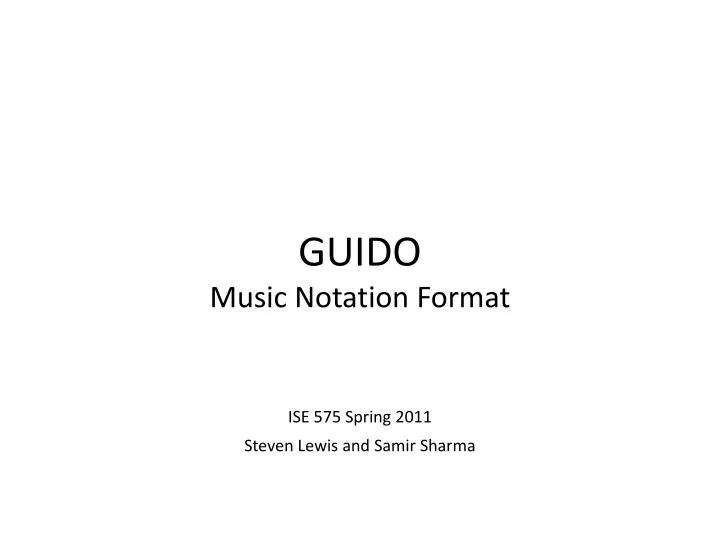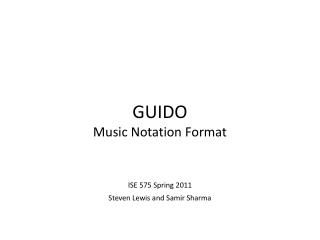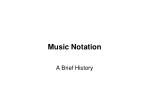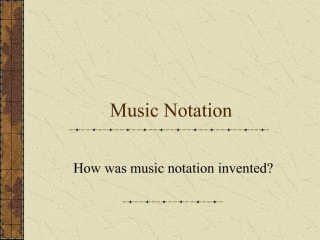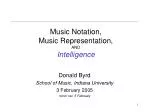
GUIDO Music Notation Format
Presentation Transcript
GUIDOMusic Notation Format ISE 575 Spring 2011 Steven Lewis and Samir Sharma
GUIDO Overview • Text-based music notation system • Sufficiently captures the necessary musical information contained in a score • Compiles into an image of sheet music
Background • Developed by Holger H. Hoos (Germany) and Keith Hamel (Canada) • Named after Guido d’Arezzo • Music theorist (990 – 1050) • Perfected the staff system
How GUIDO works • Notes • Sticky Tags • Sequences and Segments
Notes • Pitch [c e g& a#] • Octave [c1 c2 c3] • Duration [c/2 e/4 g/8]
Sticky Tags • The preceding note’s characteristic applies unless a new value is specified • Note duration, Octave register, Dynamics • Tags are formatted as \tag<> [a0/2 a c1/4 c \intens<"p"> g/8 e]
Sequences and Segments • Horizontal Sequences [ … ] • Linear order of notes in time • Example: a single melody, different voices • All begin from the start of the piece • Vertical Segments { … } • Groups of stacked sequences • Example: multiple staffs • All begin from the start of the piece
GUIDO Advantages • Scalable complexity • Basic melodies simple to create using default options • Beam groupings can be controlled • Slurs can be positioned exactly and change shapes • Sticky tags • Code is compact and non-repetitive • Music is readable in the encoded form • Intelligent graphics • Accidentals and bars are automatically applied • Has MIDI output
GUIDO Disadvantages • Chords as a unit must have one length, shorter notes are followed by imaginary rests • Secondary sequence required for Mac Dowel half notes • Sequences must all start at the beginning of the piece • Impossible to place a note into a later measure without having a series of rests before it, leading to a… • Cluttered graphical output • Confusing overlay of rests • Unnecessary dynamic markings for each sequence
Example: Mac Dowell { [\staff<1> \clef<"treble"> \key<"A"> \meter<"2/4"> \stemsUp \intens<"p"> \slur<1,9,0,8>(c#2/8 e e/4) \slur<1,9,0,8>(c#2/8 e e/4) \crescBegin \slur<1,9,0,8>(c#2/8 e f# a) \crescEnd \dimBegin \slur<2,4,0,3>(f#/4 c#) \dimEnd \intens<"p"> \slur<1,10,-1,6>(f#1/8 b b/4) \slur<2,4,0,3>(c#2/4 g#1) \slur<1,10,-1,6>(f#1/8 b b/4 a/2)], [ \staff<1> \stemsDown a/2 g# a a d e d c#], [ \staff<2> \clef<"bass"> \key<"A"> \meter<"2/4"> \stemsDown \intens<"p"> {a0/2, e1} {a0, d1, e} {f#0, c#1} {f#0, b, d#1} {e0, g#} {c#, g#} {e, g#} {a-1, e0}] }
Example: Schubert { [\staff<1> \clef<"treble"> \key<"B&"> \meter<"C"> \intens<"p"> \stacc( \slur<0,4,0,4>( d2/4 d/8 d ) \slur<0,4,0,4>( b&1/4 b& ) ) \stacc( \slur<0,-4,1,-4,1,-2>( a/4 a/8 a ) ) \slur<0,-3,1,-6,1,-2>( \grace(a/16) e&2/2 ) d/4 d/8 d \slur( d g1/16 ) _/16 g/4 c2/8 \slur<0,2,0,2>( b1/16 c2 b1 c2 d c ) _/8 \stemsDown \beam( \slur( c1/8 d e ) ) ], [\staff<1> \intens<"p"> _*7/2 f1/2], [\staff<2> \clef<"bass"> \key<"B&"> \meter<"C"> \intens<"p"> \stacc( b&-1/8 ) \beam( \slur( d1 {f0, b&0} d1 ) ) \stacc( d0 ) \beam( \slur( f1 {f0, b&0} f1 ) ) \stacc( c0 ) \beam( \slur( e&1 {f0, a0} e&1 ) ) \stacc( f-1 ) \beam( \slur( c1 {f0, a0} c1 ) ) \stacc( b&-1 ) \beam( d1 {f0, b&} d1 ) \stacc( e&-1 ) \beam( c1 {e0, g, b&} c1 ) \stacc ( e-1 ) \beam( c1 {e0, g, b&} c1 ) \stacc( f-1 ) \beam( \stemsUp a0 b& c1 ) ], [\staff<2> \intens<"p"> _*29/8 \stacc( f0/4. )] }
Conclusion • GUIDO succeeds at storing complete musical information in readable text • Composing or transcribing complex music directly into the GUIDO format is doable, although graphical input methods remain easier and faster
References • Overview of GUIDO (Music 253, Stanford University) • http://wiki.ccarh.org/wiki/Guido_Music_Notation • Detailed documentation • http://www.salieri.org/guido/doc.html • All images created using GUIDO NoteViewer software
